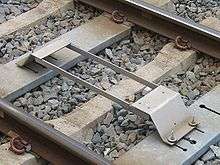Transmission balise-locomotive
Transmission balise-locomotive (Dutch: Transmissie Baken Locomotief) (TBL) (English: "Beacon-to-Locomotive Transmission") is a train protection system used in Belgium and on Hong Kong's East Rail Line.
Versions
TBL1

The TBL system is designed to stop a train passing a red signal, with operating speeds of up to 160 km/h. In 2006 13% of the Belgium train network used the original TBL system, introduced in 1982.[1]
The system requires the train driver to manually acknowledge a warning when passing a double yellow signal (similar to the Memor/Le Crocodile system), as well as stopping a train automatically if it passes a red signal.[2]
TBL1+
TBL1+ began to be installed on the Belgian rail network in 2006, with full conversion to the system expected by 2012. The system is a development of TBL1, but uses Eurobalises, providing compatibility for later reconfiguration to an ETCS system.[3] An additional safety measure is the addition of an additional balise 300m up-line, which forces an automatic stop on trains travelling at more than 40 km/h ahead of a red signal.[2]
Similar to the Swiss EuroSignum approach, it simply converts the aspects from TBL1 into a digital transmission packet so that it is compatible with ETCS, while not interfering with ETCS functionality, by using the national datagram (packet number 44) that is defined in the ERTMS / ETCS specification requirements specification (subset 026).[4]
TBL2/3
The TBL2/3 system has the same functionality as the French high speed TVM430 safety system, allowing operations of up to 300 km/h.[1] The system is used on the high speed line between Bierbeek (Leuven) and Ans (Liege).[1]
All other high-speed lines will be equipped with ETCS level 2, as shown in the network statement published by Infrabel on its website. Line 4, linking Antwerp to the Dutch High Speed Line South, is equipped with both Level 2 and, as fallback, Level 1.[5]
Overseas usage
The TBL system has been in use on Hong Kong's East Rail Line since the late 1990s as a replacement for the line's original Automatic Warning System (AWS), a British train protection system, so as to allow for increased traffic and capacity on the East Rail Line.[6] With the introduction of an Automatic train operation (ATO) system supplied by Alstom in 2002[7] the said TBL system now functions as the safety-critical part of the said ATO system, and also serves as a fallback in case the ATO system fails or is not available.[8]
References
- 1 2 3 Harry Hondius (March 1, 2006), "Belgians opt for Level 2 and GSM-R", www.railwaygazette.com, DVV Media Group
- 1 2 "Driving Aids", www.infrabel.be, Infrabel
- ↑ "Belgians to install interim ATP", www.railwaygazette.com, DVV Media Group, May 1, 2006
- ↑ "Corridor A, implementation plan" (pdf). http://www.corridor-rhine-alpine.eu/. Corridor A, Rhine-Apline. April 4, 2013. p. 109. Retrieved April 23, 2014.
The conventional lines are also equipped with a simple ATP system (TBL1+) based on ETCS components.
External link in|website=(help) - ↑ "ERTMS Deployment World Map", www.ertms.net, Unife, 2013
- ↑ MTR East Rail Line: an intro. Checkerboard Hill. March 15, 2011. Retrieved June 2, 2013.
- ↑ ALSTOM to supply signaling for Hong Kong's East rail line. Alstom. September 4, 2001. Retrieved June 2, 2013.
- ↑ British railway signalling and MTR East Rail. Checkerboard Hill. April 13, 2011. Retrieved June 2, 2013.
External links
| Wikimedia Commons has media related to Transmission balise-locomotive. |
- David De Neef (ed.), La signalisation belge (in French)
- "Automatic train control systems", www.infrabel.be, Infrabel